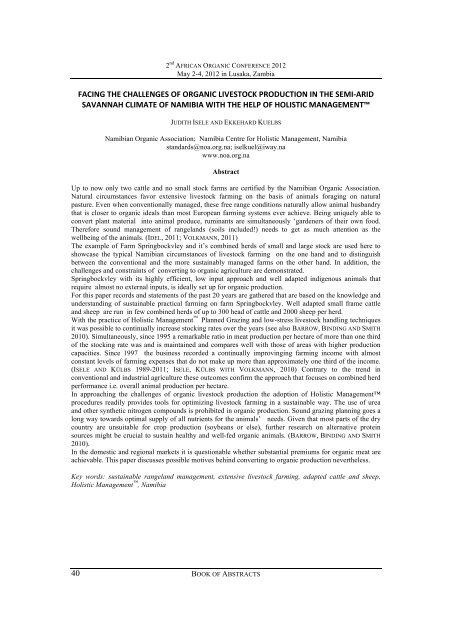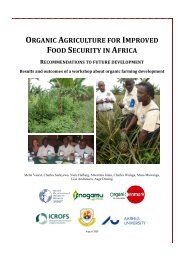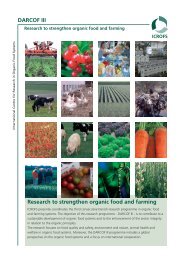The 2nd African Organic Conference â Mainstreaming ... - ICROFS
The 2nd African Organic Conference â Mainstreaming ... - ICROFS
The 2nd African Organic Conference â Mainstreaming ... - ICROFS
You also want an ePaper? Increase the reach of your titles
YUMPU automatically turns print PDFs into web optimized ePapers that Google loves.
2 nd AFRICAN ORGANIC CONFERENCE 2012<br />
May 2-4, 2012 in Lusaka, Zambia<br />
FACING&THE&CHALLENGES&OF&ORGANIC&LIVESTOCK&PRODUCTION&IN&THE&SEMI:ARID&<br />
SAVANNAH&CLIMATE&OF&NAMIBIA&WITH&THE&HELP&OF&HOLISTIC&MANAGEMENT&<br />
JUDITH ISELE AND EKKEHARD KUELBS<br />
Namibian <strong>Organic</strong> Association; Namibia Centre for Holistic Management, Namibia<br />
standards@noa.org.na; iselkuel@iway.na<br />
www.noa.org.na<br />
Abstract<br />
Up to now only two cattle and no small stock farms are certified by the Namibian <strong>Organic</strong> Association.<br />
Natural circumstances favor extensive livestock farming on the basis of animals foraging on natural<br />
pasture. Even when conventionally managed, these free range conditions naturally allow animal husbandry<br />
that is closer to organic ideals than most European farming systems ever achieve. Being uniquely able to<br />
convert plant material into animal produce, ruminants are simultaneously ‘gardeners of their own food.<br />
<strong>The</strong>refore sound management of rangelands (soils included!) needs to get as much attention as the<br />
wellbeing of the animals. (IDEL, 2011; VOLKMANN, 2011)<br />
<strong>The</strong> example of Farm Springbockvley and it’s combined herds of small and large stock are used here to<br />
showcase the typical Namibian circumstances of livestock farming on the one hand and to distinguish<br />
between the conventional and the more sustainably managed farms on the other hand. In addition, the<br />
challenges and constraints of converting to organic agriculture are demonstrated.<br />
Springbockvley with its highly efficient, low input approach and well adapted indigenous animals that<br />
require almost no external inputs, is ideally set up for organic production.<br />
For this paper records and statements of the past 20 years are gathered that are based on the knowledge and<br />
understanding of sustainable practical farming on farm Springbockvley. Well adapted small frame cattle<br />
and sheep are run in few combined herds of up to 300 head of cattle and 2000 sheep per herd.<br />
With the practice of Holistic Management Planned Grazing and low-stress livestock handling techniques<br />
it was possible to continually increase stocking rates over the years (see also BARROW, BINDING AND SMITH<br />
2010). Simultaneously, since 1995 a remarkable ratio in meat production per hectare of more than one third<br />
of the stocking rate was and is maintained and compares well with those of areas with higher production<br />
capacities. Since 1997 the business recorded a continually improvinging farming income with almost<br />
constant levels of farming expenses that do not make up more than approximately one third of the income.<br />
(ISELE AND KÜLBS 1989-2011; ISELE, KÜLBS WITH VOLKMANN, 2010) Contrary to the trend in<br />
conventional and industrial agriculture these outcomes confirm the approach that focuses on combined herd<br />
performance i.e. overall animal production per hectare.<br />
In approaching the challenges of organic livestock production the adoption of Holistic Management<br />
procedures readily provides tools for optimizing livestock farming in a sustainable way. <strong>The</strong> use of urea<br />
and other synthetic nitrogen compounds is prohibited in organic production. Sound grazing planning goes a<br />
long way towards optimal supply of all nutrients for the animals’ needs. Given that most parts of the dry<br />
country are unsuitable for crop production (soybeans or else), further research on alternative protein<br />
sources might be crucial to sustain healthy and well-fed organic animals. (BARROW, BINDING AND SMITH<br />
2010).<br />
In the domestic and regional markets it is questionable whether substantial premiums for organic meat are<br />
achievable. This paper discusses possible motives behind converting to organic production nevertheless.<br />
Key words: sustainable rangeland management, extensive livestock farming, adapted cattle and sheep,<br />
Holistic Management , Namibia<br />
40<br />
BOOK OF ABSTRACTS





